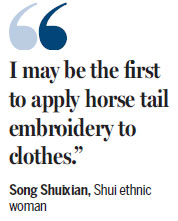
A woman has made it her life's mission to promote the rare embroidery of the Shui ethnic group in Southwest China, Yang Jun reports.
Horse tail embroidery of the Shui ethnic group is an intangible heritage in China, and 53-year-old Song Shuixian has made it her life's mission to take it to a wider audience.
For starters, her clothes reflect the craft - flowers blossom from the collar of her top; dragons dance around the edges of her sleeves and intricate patterns adorn her pants.
The embroidery needs both good texture and quality threads.
"It is an absolute treasure," says Song.
Like many young women from her community, she learned how to sew with threads made from a horse's tail from her mother when she was very young, and later honed her craft in the village of Bangao, the "hometown of horse tail embroidery" in Sandu county, Guizhou province, where she was taught by her mother-in-law and grandmother-in-law.
"In the late 1980s, when I just got married, in my village during the non-farming season, you would see women, young and old, sewing everywhere - on their doorsteps, under trees, some even cradling babies," says Song.
The turning point for Song came in 1988 when she realized the craft that she was so proud of was in jeopardy. At the time, she heard about a foreign buyer trying to purchase a piece of the embroidery for 10 times the listed price. Song thought both about the fear of losing the craft and its staggering value. It was then that she decided to do whatever she could to preserve the heritage passed down from her ancestors.
Her plan is multi-pronged - she collects, sews and sells.

She began by purchasing vintage pieces from local households in an effort to establish a private museum for the craft, which she succeeded in doing in 2010. In 1998, she rallied a team of capable Shui women to sew embroidered pieces and floral sachets that used to be sold in streets stalls to sell at Song's boutique store in the county. In 2010, she founded her own company and ventured to lay prints of the embroidery on luxury clothing and handbags.
"Let me tell you this. I may be the first to apply horse tail embroidery to clothes," says Song.
In the past, the embroidery only appeared on small garments such as baby straps and aprons.
Song found places for the embroidery on everyday clothes, photo frames and notebooks, thereby increasing its commercial value.
To Song, her enterprise has always been as much about breathing life into the traditional craft as taking the women of the Shui ethnic group with her. Over the past two decades of her career, Song has mostly engaged a team of about 20 local women by providing them with sewing work that allows them to both make a living and raise a family.
According to Wei Niang, a seamstress who has worked with Song for over a decade, Song never holds off from paying her seamstresses, even when she is cash-strapped. If she is particularly pleased with someone's work, she won't hesitate to reward her with an immediate bonus.
"She really knows how to appreciate good work," says Wei, referring to Song as "teacher Song".
Beside the Shui community, her family is an important support system for Song. Her youngest son Wei Zutao is responsible for new product development at the company. The 29-year-old former animator sees in the ancient craft two possibilities - haute couture and "crowd favorites", alluding to business models of fashion houses like Gucci and Dior, and more down-to-earth retailers like Zara. Wei is in the process of soliciting design talent from fans of the embroidery to work on product branding that aims to appeal to the younger generations.
Song's daughter-in-law Wu Yongzhi serves as her parttime assistant. The 29-yearold high school English teacher has volunteered to take the traditional craft to the classroom, teaching her students to sew as an extra-curricular activity. Even though she started learning the craft from Song only five years ago, she considers it her responsibility to impart knowledge of the embroidery to her students.
Song has had one wish for a long time that by the time she's 60, she will have demonstrated the commercial and aesthetic value of the embroidery. Now that her wish has come true much ahead of that age, she has two more wishes to fulfill. She wishes for a better venue than the current small wooden-structured museum to house her nearly 10,000 pieces of horse tail embroidery and a training school where she can teach young people how to sew.
Song says she has spent every penny she had on preserving the craft, but she didn't do it to win any trophies for herself.
"I'm doing something good for the country," says Song.
Contact the writer at yangjun@chinadaily.com.cn
Liu Yinglun contributed to the story.
|
The horse tail embroidery of the Shui ethnic group is an intangible heritage in China. The village of Bangao in Sandu county, Guizhou province, is known as the hometown of the handicraft. Photos orovided to China Daily |
|
Song Shuixian guides her daughter-in-law Wu Yongzhi in making a horse tail embroidery piece. The 29-year-old high school English teacher has volunteered to take the traditional craft to the classroom, teaching her students how to sew as an extra-curricular activity. |
(China Daily 03/16/2018 page19)